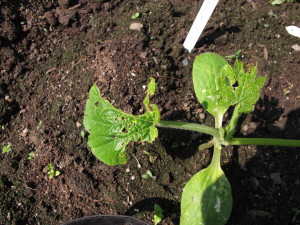Dealing with Pests and Diseases
I understand why many gardeners shop on Death Row. That’s what I call the pesticide aisle at the garden center. Insecticides, fungicides, herbicides are sold in cheerful colorful bags, often with pictures of blooming flowers on the bag. I don’t shop there and try to avoid even walking down the aisle because the smell of death – poison – is often in the air.
Gardeners shop on Death Row because something is threatening their roses or their broccoli. Flea beetles making holes in the cabbage? Nuke ‘em. Japanese beetles? Gotta kill ‘em. I get the urge, too. But there are alternatives.
Let’s start with something easy: I drape a light-weight gauzy film of agricultural fabric over plants to keep bugs from physically getting to my plants. This cloth allows sun and rain to pass through, but not bugs. It’s called row cover or by trade names like Reemay and Agribon. There are other brand names, too.
Row cover comes in different weights, and some heavier types can be used to keep in a little heat at night, holding off frost. But its best use is to keep plants bug-free. I use it over my vine crops like cucumbers and squash as they are very vulnerable to a pest called the striped cucumber beetle.
Row cover is not perfect: striped cucumber beetles live in the soil, and sometimes will appear under the row cover, but mostly it prevents them from getting to the plants. To be on the safe side, I start cukes and squash inside the house 3 weeks or more before planting time (or buy a 6-pack of starts). That gives me good-sized plants that can survive some beetle attack.
Generally I just drape the row cover over the cucumber plants and pin down the edges with special staples sold for the purpose. It is light enough that it will just float on top. But since vine crops are insect pollinated, I need to take it off once the plants start to bloom.
Hoops are sold to support row cover, too. Five foot sections of #10 wire are sold for the purpose. Just poke one end into the soil, bend it, and poke in the other end. This is great for keeping flea beetles and cabbage moths of broccoli, cabbage and related plants.
Repellents can help to keep insects off plants. Liquid fish fertilizer has worked for me to reduce the number of Japanese beetles on roses and other decorative plants, though I wouldn’t use it on vegetables. Garlic Barrier is product made from garlic and citric acid that can be diluted and spread on plants to repel insects. It is rated for use on vegetables, and has no flavor once it has dried. In any case, you must get the repellents sprayed before the insects show up, and need to re-apply regularly. It is fine for use by organic gardeners.
Traps sound good, but generally are not. Japanese beetle traps use a sex hormone to attract the beetles, but unfortunately they attract many more beetles than they catch. And those pesky beetles like to have a snack before investigating the scent of sex. Give them to your neighbors, perhaps, but don’t use them!
Hand-picking bugs really does work, particularly if you are diligent when they first appear. Pick potato beetles every day as soon as you see them (or their larvae). Look under the leaves for orange egg masses, too. Don’t let a second generation get started! Get them early, and avoid trouble later on.
Keep these points in mind if you want have a good garden and healthy plants:
1) Healthy plants growing in favorable conditions (such as the right amount of sun, and moisture in the soil) are less susceptible to diseases.
2) Select disease-resistant cultivars when possible. Modern hybrids are often bred for disease resistance.
3) Don’t over-fertilize. Too much nitrogen gives fast green growth, but promotes weak tissue that is more susceptible to diseases.
4) Try to keep leaves dry when watering. Moisture on leaves, particularly at night, helps some fungal diseases to get established. A hand-held watering wand can direct water to the roots; overhead sprinklers get everything wet.
5) Prune off diseased leaves and dispose of them in the trash. Never let diseased plants over-winter in the garden. Keep your garden clean. Clean up in fall and spring to remove diseased plant matter.
6) Lastly, don’t overreact. Most fungal diseases won’t kill a healthy plant that is well planted in good soil. Don’t rush to spray chemicals. Once a leaf is infected, you can’t fix it, only live with it or cut it off.
As an organic gardener I accept that sometimes bugs or diseases win. I no longer grow Oriental or Asiatic lilies because of a beautiful red beetle that attacks them. I can’t control the pest by hand picking. That’s okay, I grow angel’s trumpet (Datura spp.), a lily-like flower that is even better – it blooms for many weeks with gorgeous big white flowers). And it doesn’t need chemical poisons to thrive.
Read my blog twice weekly at www.dailyUV.com. You can sign up to get the blog post sent to you be email.




